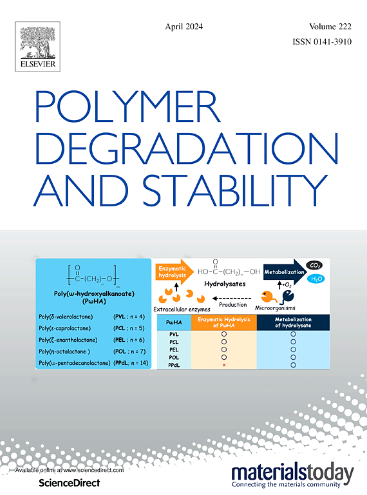可回收碳纤维增强热固性树脂复合材料成分-结构-性能相关性的新见解
IF 6.3
2区 化学
Q1 POLYMER SCIENCE
引用次数: 0
摘要
作为广泛使用的轻质高强度材料,热固性复合材料的可回收性有限,阻碍了其可持续发展。开发高效、升级的简单回收方法是可取的,但也是具有挑战性的。本文制备了碳纤维增强可降解热固性树脂复合材料,并研究了树脂降解过程及其衍生物对碳纤维可持续回收利用的影响。通过清洁后处理中降解衍生物的可调离开和再吸附,回收的碳纤维不仅实现了无损回收,而且拉伸强度从 3.0 GPa 提高到 3.7 GPa,表面能从 47.2 mN/m 提高到 66.7 mN/m。富含 -NH- 和含氧基团的附着衍生物与纤维表面和环氧树脂之间表现出良好的相互作用。得益于此,再生碳纤维增强环氧树脂复合材料的层间剪切强度有效提高了 24.3%。这项研究提出了直接再利用树脂降解产物回收增强纤维的方法,并揭示了降解产物的组成和分布对回收性能的关键作用。综合各组分特性以提高材料可回收性的策略有望得到广泛应用,促进热固性复合材料的可持续转型。本文章由计算机程序翻译,如有差异,请以英文原文为准。
Novel insights into the correlation composition-structure-property of recyclable carbon fiber reinforced thermosetting resin composites
As widely used lightweight and high-strength materials, the sustainable development of thermosetting composites is hampered by their limited recyclability. Developing simple methods for the efficient and upgraded recycling is desirable but challenging. Herein, carbon fiber reinforced degradable thermosetting resin composites were prepared, and the effects of resin degradation process and its derivatives on the sustainable recycling of carbon fiber were studied. Through the tunable departure and re-adsorption of degradation derivatives in cleaning post-treatment, recycled carbon fibers achieved not only non-destructive recovery but also simultaneously improvements in tensile strength from 3.0 GPa to 3.7 GPa and surface energy from 47.2 mN/m to 66.7 mN/m. The adhered derivatives, rich in -NH- and oxygen-containing groups, exhibited good interactions with the fiber surface and epoxy resin. Benefiting from this, the inter laminar shear strength of recycled carbon fibers reinforced epoxy composite effectively improved 24.3 %. In this work, directly reusing resin degradation products for the recycling of reinforced fibers was proposed and the key role of the composition and distribution of degradation products in recycling properties was revealed. The strategy of integrating characteristics of components to enhance material recyclability is expected to have widespread applicability, promoting the sustainable transition for thermosetting composites.
求助全文
通过发布文献求助,成功后即可免费获取论文全文。
去求助
来源期刊

Polymer Degradation and Stability
化学-高分子科学
CiteScore
10.10
自引率
10.20%
发文量
325
审稿时长
23 days
期刊介绍:
Polymer Degradation and Stability deals with the degradation reactions and their control which are a major preoccupation of practitioners of the many and diverse aspects of modern polymer technology.
Deteriorative reactions occur during processing, when polymers are subjected to heat, oxygen and mechanical stress, and during the useful life of the materials when oxygen and sunlight are the most important degradative agencies. In more specialised applications, degradation may be induced by high energy radiation, ozone, atmospheric pollutants, mechanical stress, biological action, hydrolysis and many other influences. The mechanisms of these reactions and stabilisation processes must be understood if the technology and application of polymers are to continue to advance. The reporting of investigations of this kind is therefore a major function of this journal.
However there are also new developments in polymer technology in which degradation processes find positive applications. For example, photodegradable plastics are now available, the recycling of polymeric products will become increasingly important, degradation and combustion studies are involved in the definition of the fire hazards which are associated with polymeric materials and the microelectronics industry is vitally dependent upon polymer degradation in the manufacture of its circuitry. Polymer properties may also be improved by processes like curing and grafting, the chemistry of which can be closely related to that which causes physical deterioration in other circumstances.
 求助内容:
求助内容: 应助结果提醒方式:
应助结果提醒方式:


